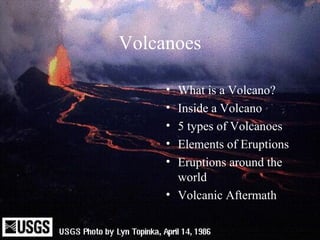
Volcanoes
- 1. Volcanoes • What is a Volcano? • Inside a Volcano • 5 types of Volcanoes • Elements of Eruptions • Eruptions around the world • Volcanic Aftermath
- 2. What is a volcano? • A) The highest peak in a mountain range. • B) A flat surface on the earth’s crust. • C) A character on Star Trek. • D) A thin spot or fissure in the earth’s crust.
- 3. Why do volcanoes erupt? Hot, melted rock (magma) deep within the earth becomes lighter as it heats up. Because it is lighter than solid rock it rises until it pushes to the surface of the earth. A volcanic eruption occurs!
- 4. Melted rock that erupts from a volcano is called . . . • A) magma • B) lava • C) glupacose • D) molten rock
- 5. Where do volcanoes erupt? • A) In the middle of the earth’s plates, hotspots. • B) Near the edges of the earth’s plates. • C) Subduction and rift zones. • D) All of the above.
- 6. Why do volcanoes grow? • A) Repeated eruptions • B) There are various types of volcanoes and each forms differently • C) Volcanoes were formed when the earth was formed and haven’t changed much since then. • D) Both A and B
- 7. What are the 3 main shapes of volcanoes? • A) Dome, Funnel, and crater • B) Shield, Cinder, and Composite • C) Volcanic, Tephra, and Slope • D) Hydrosphere, Cryosphere, and Lithosphere
- 8. A shield volcano is formed when A) Great masses of lava slowly ooze out from an opening in the earth’s crust, forming a broad, gentle slope.* B) Lava, huge rocks, cinders and ash explode high into the air forming a steep cone up to 35 degrees. C) Formed by quiet and explosive eruptions. D) Concave formation in the earth’s crust.
- 9. A cinder cone is formed when A) Great masses of lava slowly ooze out from an opening in the earth’s crust, forming a broad, gentle slope. B) Lava, huge rocks, cinders and ash explode high into the air forming a steep cone up to 35 degrees.* C) Formed by quiet and explosive eruptions. D) Concave formation in the earth’s crust.
- 10. A composite cone forms when A) Great masses of lava slowly ooze out from an opening in the earth’s crust, forming a broad, gentle slope. B) Lava, huge rocks, cinders and ash explode high into the air forming a steep cone up to 35 degrees. C) Formed by quiet and explosive eruptions. * D) Concave formation in the earth’s crust.
- 11. The following shows what shape of volcano? • A) Shield • B) Cinder* • C) composite • D) Dome
- 12. The following shows what shape of volcano? • A) Shield • B) Cinder • C) composite* • D) Dome
- 13. The following shows what shape of volcano? • A) Shield* • B) Cinder • C) composite • D) Dome
- 14. Mt. Loa and Kilauea are examples of what volcano shape? A) Cinder B) Composite C) Funnel D) Shield
- 15. Cinder cone volcanoes can reach an altitude of A) 45,000 feet B) 15,000 feet C) 3,000 feet D) 20,000 feet
- 16. Mt. Pelee on the island of Martinique is which volcano shape? A) Composite B) Funnel C) Cinder cone D) Shield
- 17. Mt. Vesuvius, Mt. Fujiyama, and Mt. Rainer are what volcano shape? A) Cinder B) Composite C) Funnel D) Shield
- 18. Volcanoes are divided into 3 types A) Composite, shield, and Cinder B) Funnel, Composite, and Cinder C) Active, Extinct, and Dormant D) Crater, Funnel, Slope
- 19. These Volcanoes have erupted in recent history. A) Dormant B) Extinct C) Active D) Explosive
- 20. These volcanoes haven’t erupted in recorded history and show no signs of ever erupting. A) Dormant B) Extinct C) Active D) Explosive
- 21. Dormant volcanoes A) No activity recorded in history. B) Have erupted in recent history. C) Currently erupting. D) Show signs of activity, but have not erupted in recent history. It is “sleeping.”
- 22. The destruction from a volcanic eruption is caused by • A) Lava and Tephra • B) Ash and Gases in the air • C) Water, Rock and Mud • D) all of the above
- 23. Which of the following is an active volcano in North America? A) Mt. Vesuvius B) Mt. Hood C) Mt. Rainer D) Mt. Katmai
- 24. Which of the following volcanoes is extinct? A) Mt. Hood B) Mauna Loa C) Mt. Kilamajaro D) Both A and C
- 25. Which of the following volcanoes has been dormant or sleeping? A) Paricutin B) Mt. Timpanogos C) Mt. Hood D) Squaw Peak
- 26. Mt. Vesuvius destroyed what city? A) Salt Lake City B) Cairo C) Pompeii D) Rome
- 27. What year did Mt. St. Helens last erupt? A) 1975 B) 1980 C) 1899 D) 1936